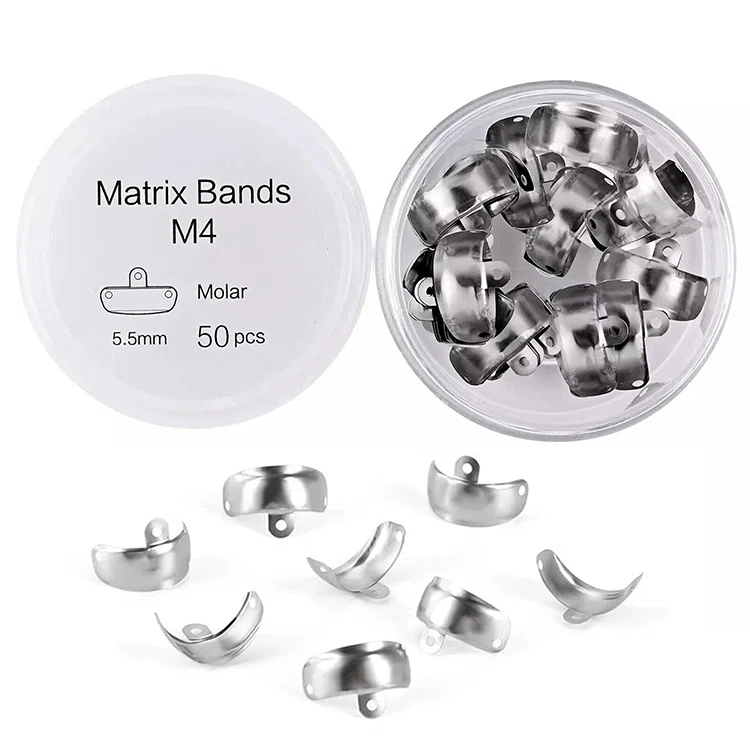
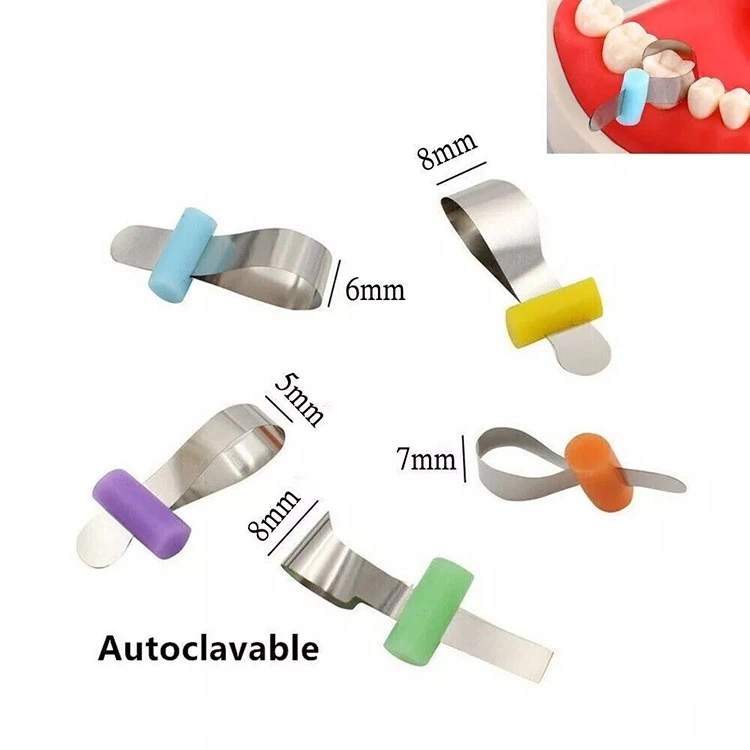
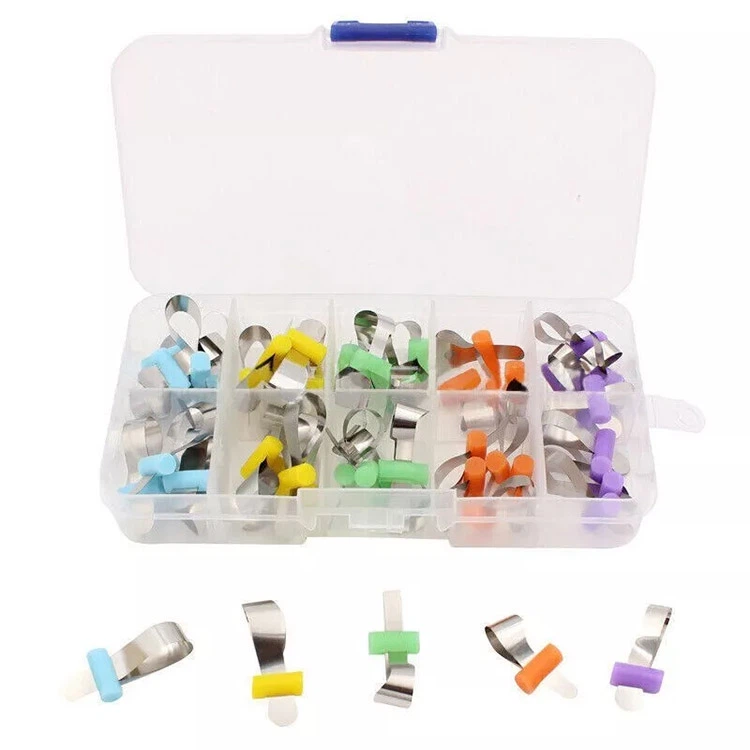
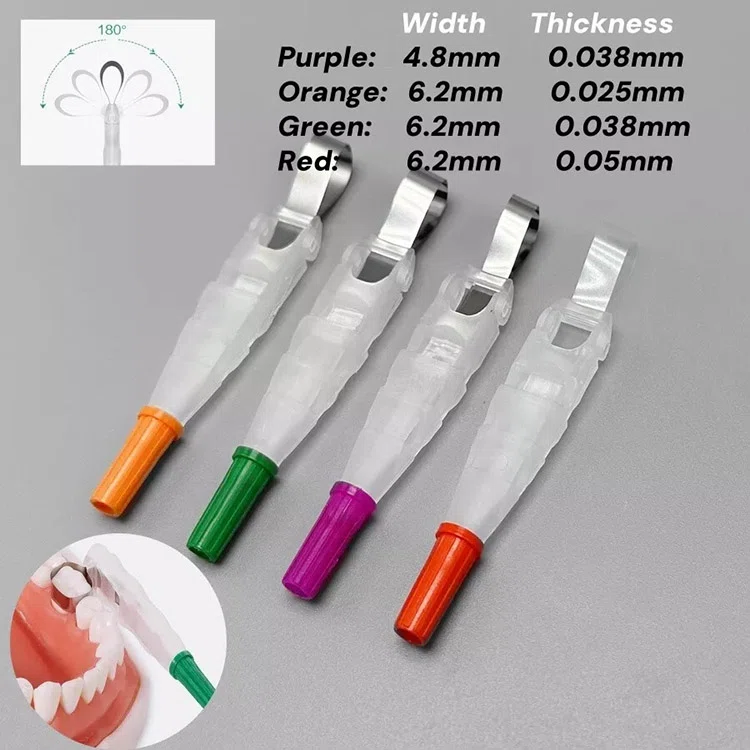
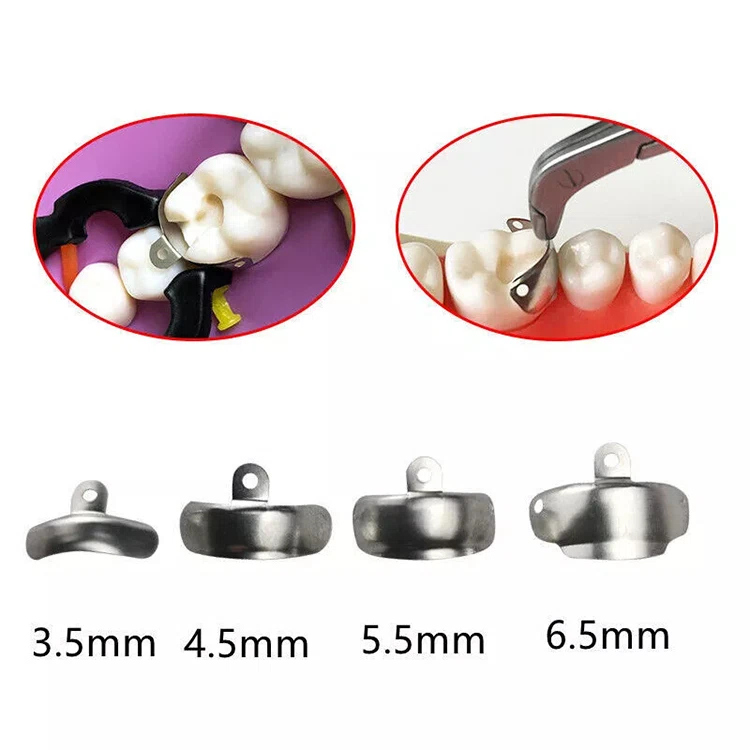
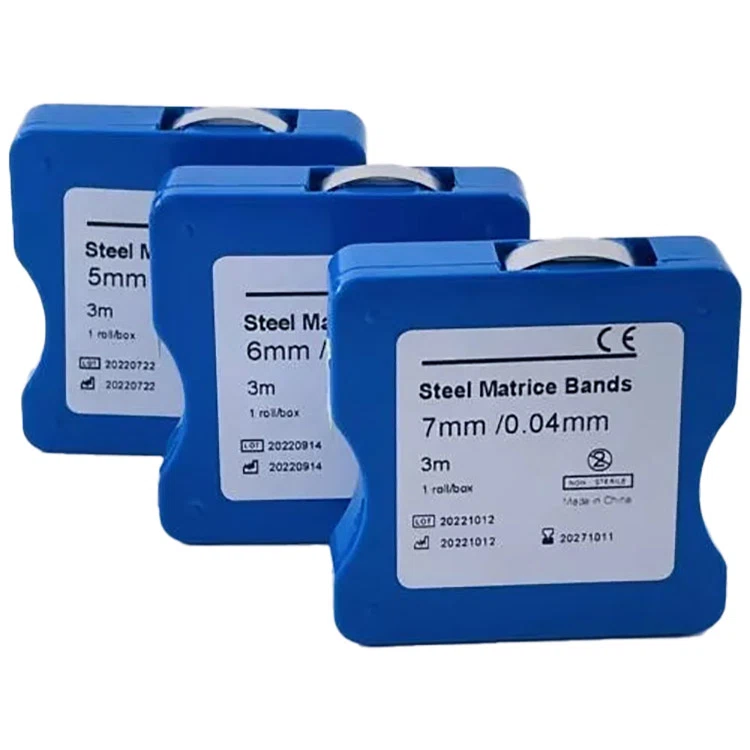
Bande di matrice dentale
- Special Matirial rinforzato garantisce la forza e l'elasticità appropriate
- Buona elasticità e tenacità, Buona forza di serraggio, invariabilità dopo un uso ripetuto
- La curvatura più grande può avvolgere e adattarsi al dente in modo più stabile
- Il materiale in resina ha una buona elasticità e resilienza, non si deforma
- Autoclavabile
Le bande di matrice sono dispositivi di plastica in acciaio inossidabile o di livello medico utilizzati nel restauro dentale e nei trattamenti ortodontici. Creano pareti di contenimento temporanea attorno ai denti per aiutare a modellare e modellare i materiali di restauro durante le procedure cliniche.
Le bande di matrice forniscono un confine e una forma chiari attorno al dente, consentire il riempito accuratamente del materiale di riparativo nell'area designata, risultante in un restauro ideale per la forma del dente.
Categoria delle bande Matrix
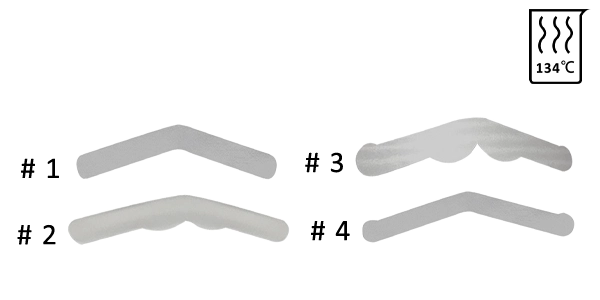
| Largo: #2 spessore: 0.04mm(0.0015") |
| Largo: #2 spessore: 0.05mm(0.002") |
| standard, #1 spessore: 0.04mm(0.0015") larghezza: 6.5mm |
| standard, #1 spessore: 0.05mm(0.002") larghezza:6.5mm |
| Largo #3 spessore: 0.04mm(0.0015") |
| Largo #3 spessore: 0.05mm(0.002") |
| Largo #13 spessore: 0.04mm(0.0015") |
| Largo #13 spessore: 0.05mm(0.002") |
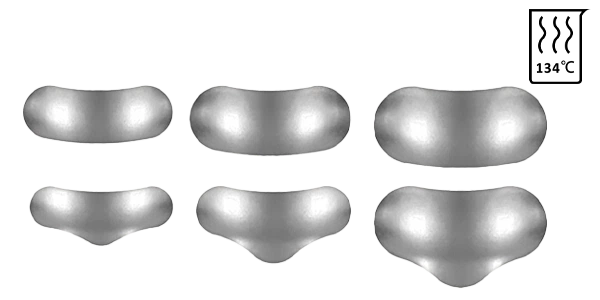
| No. 1, Difficile, Premolare, Largo: 4.5mm, Spessore: 0.038mm |
| No.2, Difficile, Molare, Largo: 5.5mm, Spessore:0.038mm |
| No.3, Difficile, Molare alto, Largo: 6.5mm, Spessore: 0.038mm |
| No.4, Difficile, Permelare con estensione, Largo: 5mm, Spessore:0.038mm |
| No.5, Difficile, Molare con estensione, Largo: 6.5mm, Spessore:0.038mm |
| No.6, Difficile, Molare alto con estensione, Largo: 8.5mm, Spessore: 0.038mm |
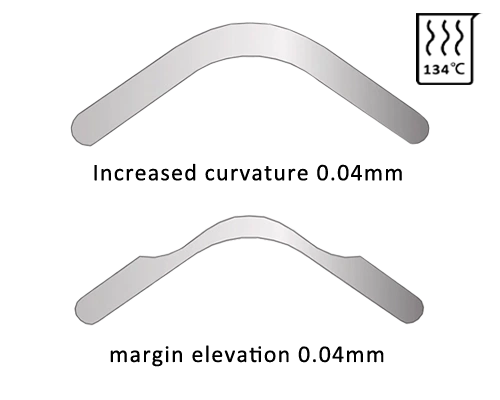
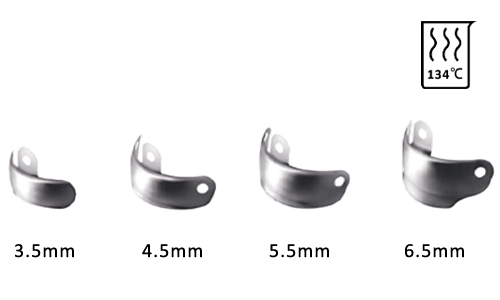
Bande di matrice sezionale GD-5694
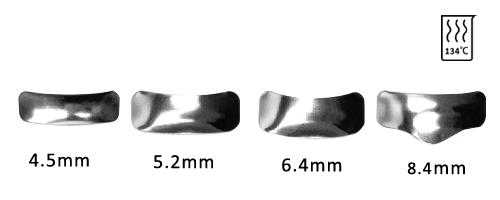
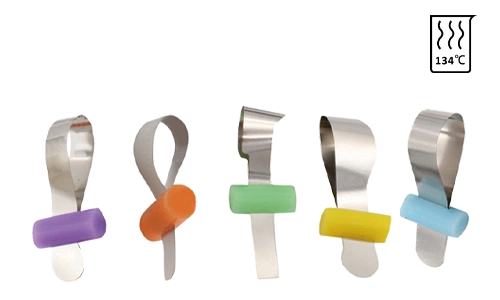
Solo prodotti autoclavabili
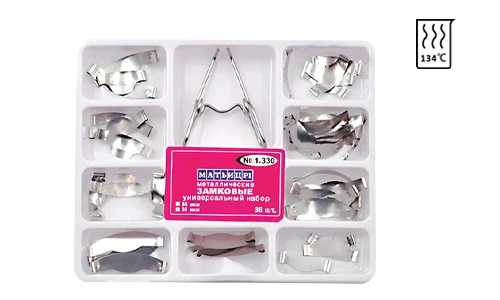
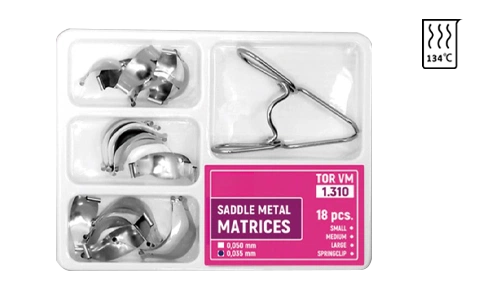
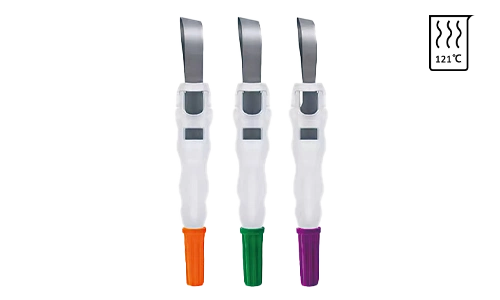
Retainer e matrice GD-5702
| Acciaio inossidabile |
| Arancia: Largo 6,2 mm, spessore 0,025 mm, Senza ali o con ala |
| Verde: Largo 6,2 mm, spessore 0,038 mm, Senza ali o con ala |
| Viola: Largo 4,8 mm, spessore 0,038 mm, Senza ali o con ala |
| Rosso: Largo 6,2 mm, spessore 0,075 mm, Senza ali o con ala, Mylar |
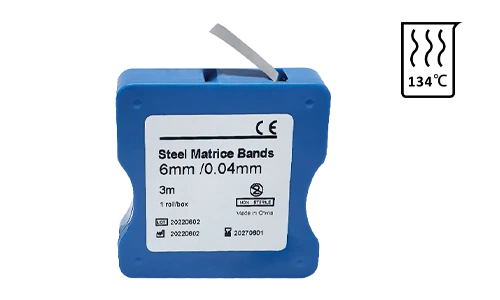
| Largo: 5mm, spessore: 0.025mm, lunghezza: 3M |
| Largo: 5mm, spessore: 0.04mm, lunghezza: 3M |
| Largo: 5mm, spessore: 0.05mm, lunghezza: 3M |
| Largo: 6mm, spessore: 0.025mm, lunghezza: 3M |
| Largo: 6mm, spessore: 0.04mm, lunghezza: 3M |
| Largo: 6mm, spessore: 0.05mm, lunghezza: 3M |
| Largo: 7mm, spessore: 0.025mm, lunghezza: 3M |
| Largo: 7mm, spessore: 0.04mm, lunghezza: 3M |
| Largo: 7mm, spessore: 0.05mm, lunghezza: 3M |
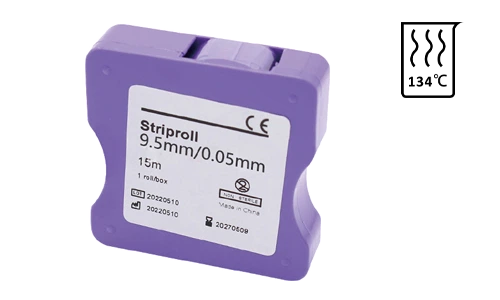
Le bande di matrice sono disponibili in diverse dimensioni e forme a seconda dei denti del paziente per sceglierle, Aiutare il dentista a controllare con precisione il risultato riparativo. Le bande di matrice possono anche essere utilizzate insieme a zeppe dentali Per controllare lo spessore del materiale restaurativo, evitare che il materiale di riempimento sia troppo spesso o troppo sottile.
Con progressi nella tecnologia medica, Matrix Bands Design diventerà più intelligente, Aumentare ulteriormente l'accuratezza e l'efficacia nei restauri. L'evoluzione della scienza dei materiali porterà anche a bande di matrice costruite con materiali più recenti che sono più comodi e durevoli. Maggiori dettagli, Si prega di contattarci.
Le tipologie di bande per matrici dentali
Bande di matrice sezionale
Le bande di matrice sezionale sono più adatte per restauri di cavità di Classe II e Classe III, soprattutto i denti posteriori. I loro archi pre-progettati possono adattarsi bene alla struttura anatomica dei denti, creando un contatto prossimale naturale e prevenendo la sporgenza. Sono realizzati in acciaio inossidabile sottile e resistente e possono mantenere la stabilità in spazi ristretti. Questo è fondamentale per l’incollaggio dei materiali compositi utilizzati nelle otturazioni dentali.
Bande di matrice circonferenziale
Circolare (cerchio completo) Le bande di matrice vengono utilizzate per restauri a copertura totale e possono essere applicate alla preparazione della corona o al post-trattamento di cavità di I classe di grandi dimensioni. Realizzato in acciaio inossidabile o plastica usa e getta, offre un supporto surround a 360° per garantire un posizionamento uniforme del materiale e contorni di riparazione.
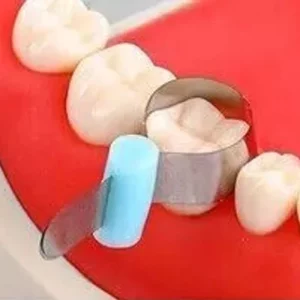
Bande della matrice di ritenzione
Viene spesso utilizzato in situazioni in cui la preparazione delle corone dei denti posteriori e dei restauri su larga scala richiedono un tempo chirurgico relativamente lungo. Offre inoltre un supporto surround a 360° ed è dotato di un design di bloccaggio integrato, eliminando la necessità di cunei dentali per assistere nel supporto. Possono fornire un mantenimento dello stato a lungo termine, in attesa che il restauro completi la polimerizzazione.
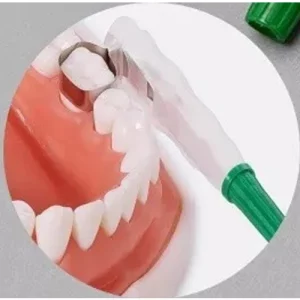
Rotolo di strisce in resina
Il Resin Strip Roll è una sorta di fascia a matrice in plastica, che viene tagliato quanto necessario. Inoltre, Il rotolo di strisce di resina è esclusivamente monouso. Non è necessario pensare alla pulizia e alla disinfezione dopo l'uso. È molto conveniente e fa risparmiare tempo.
Perché i dentisti si fidano delle nostre fasce a matrice dentale
- Sicuro e sterile: I nostri nastri di base sono tutti conformi agli standard FDA e CE. Sono tutti sottoposti a rigorosa sterilizzazione prima di lasciare la fabbrica e supportano tutti la sterilizzazione ad alta temperatura e alta pressione. Per prevenire infezioni crociate, si consiglia inoltre di sterilizzare rigorosamente prima e dopo ogni utilizzo.
- Durata: La fascia della matrice in acciaio inossidabile può resistere molto bene alla deformazione durante il posizionamento e la rimozione, e può comunque garantire prestazioni eccellenti dopo un uso ripetuto.
- Alta precisione: La nostra fascia a matrice è sottoposta a molteplici processi di pressatura dei bordi per garantire la massima precisione, bordi lisci e senza sbavature. Può creare un ambiente ermeticamente sigillato, prevenire la fuoriuscita dei materiali di otturazione dentale, e ridurre l'incidenza della sensibilità dentale postoperatoria e della carie secondaria.
Come utilizzare correttamente le matrici dentali
Seleziona il tipo e la dimensione appropriati:
Dopo l'esame, in base alla pellicola radiografica e alla posizione del dente da otturare. Seleziona il tipo e la dimensione della banda della matrice dentale. Se è necessario riempire la carie profonda dei molari posteriori, è meglio scegliere le bande di matrice di ritenzione, che può mantenere uno stato stabile per lungo tempo. Se si tratta di un difetto a forma di cuneo dei premolari, Le bande della matrice sezionale possono essere utilizzate in combinazione con i cunei interdentali per cooperare. Questo perché i premolari hanno un buon campo visivo e l'area del difetto a forma di cuneo è relativamente piccola, e solo una parte del corpo del dente deve essere circondata.
Posizionamento sicuro:
Quando si utilizza la matrice per stabilizzare l'area parodontale, assicurarsi che sia a filo con il bordo gengivale e non applicare una forza eccessiva per evitare che si incastri nella gengiva causando disagio al paziente.
Controlla il contorno:
Prima di riempire il materiale da restauro, assicurarsi che il contorno circondato dalla banda matrice sia pieno e naturale, e si adatta bene al dente. Evitare che un riempimento eccessivo o insufficiente ostacoli il trattamento successivo.
Rimozione attenta:
Dopo che il materiale di riparazione si è indurito, rimuovere delicatamente la fascia della matrice. Quindi controllare l'area del bordo per determinare l'effetto di riparazione.
Risolvi i punti critici relativi alle bande della matrice
Secondo il feedback dei nostri clienti, ci sono tre sfide principali nell’ottimizzazione
1. Difficoltà di adattamento spaziale:
Durante il restauro della carie interprossimale dei molari, la fascia della matrice non riesce a entrare nello spazio ristretto o blocca il campo visivo operativo quando viene inserita.
Piano di ottimizzazione: Le nostre bande di matrice sezionale GD-5696 sono state aggiornate e differenziate in sei modelli basati sull'indagine della dimensione molare e dello spazio interdentale di migliaia di pazienti. Per specifiche dettagliate, si prega di fare riferimento alla tabella sopra. Fondamentalmente copre 90% dei pazienti’ campioni molari. Non avrai più difficoltà a scegliere quando esegui il restauro dei molari interprossimali.
2. Problema di perdita dei bordi:
Dopo il riempimento, si riscontra sempre la presenza di bave o anche di grosse sporgenze in corrispondenza del bordo di giunzione, che richiede molto tempo per la successiva lucidatura e molatura. Ciò è stato causato dal fatto che il bordo del foglio formato non era sigillato bene.
Piano di ottimizzazione: Questo tipo di problema è dovuto principalmente all'insufficiente pressione di bloccaggio della lamiera di formatura. A volte, quando si utilizzano cunei interdentali come assistenza, la pressione non è uniforme, con conseguente sigillatura insufficiente dei bordi e fuoriuscita del materiale di riparazione. Le fasce a matrice di ritenzione GD-5702 che abbiamo sviluppato successivamente possono risolvere efficacemente questo problema. Può fornire un bloccaggio surround a 360° e mantenere una pressione uniforme per lungo tempo.
3. Durabilità del materiale:
Le normali lamiere sagomate in acciaio inossidabile si deformano dopo essere state disinfettate tre volte.
Piano di ottimizzazione: Aggiornamento al materiale in acciaio inossidabile medico 316L, supporta la sterilizzazione a vapore ad alta pressione a 134 ℃, mantenendo la stabilità della forma dopo 20 cicli di sterilizzazione.
FAQ
Per il restauro dei denti anteriori, è possibile fare riferimento al diametro del dente: per gli incisivi centrali, scegli il tipo piccolo (larghezza 5-6 mm), e per i canini, scegli il tipo standard (6-7mm). Gli spazi interprossimali dei denti posteriori devono essere misurati con sonde parodontali
- Acciaio inossidabile (come GD-5696) : Adatto per la zona dei denti posteriori che sopporta la forza del morso. Uno spessore di 0,051 mm fornisce un forte supporto, ma va notato che la frequenza della disinfezione non deve superare 8 volte (Altrimenti, il bordo è soggetto a deformazione).
- Lega di memoria (GD-5692) : La scelta preferita per il restauro estetico dei denti anteriori, può essere piegato a 90° e rimbalzare automaticamente, particolarmente adatto per casi con curve del margine cervicale complesse.
- Acciaio inossidabile comune: Si consiglia di sterilizzare a 121℃. Dopo più di 10 cicli, la forza di sigillatura dei bordi diminuirà di 37%, e deve essere sostituito in tempo.
- Acciaio inossidabile 316L di grado medico: Supporta la sterilizzazione rapida a 134 ℃ e mantiene la stabilità della forma dopo 20 cicli.
Preferisci tipi morbidi e sicuri, come il rotolo di strisce di resina GD-5699. È una fascia matrice realizzata in materiale resinoso e la pressione generata non è troppo intensa. È adatto a pazienti come i bambini i cui denti non sono completamente sviluppati.

